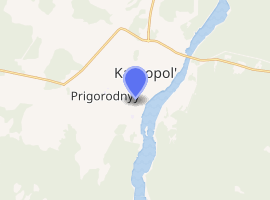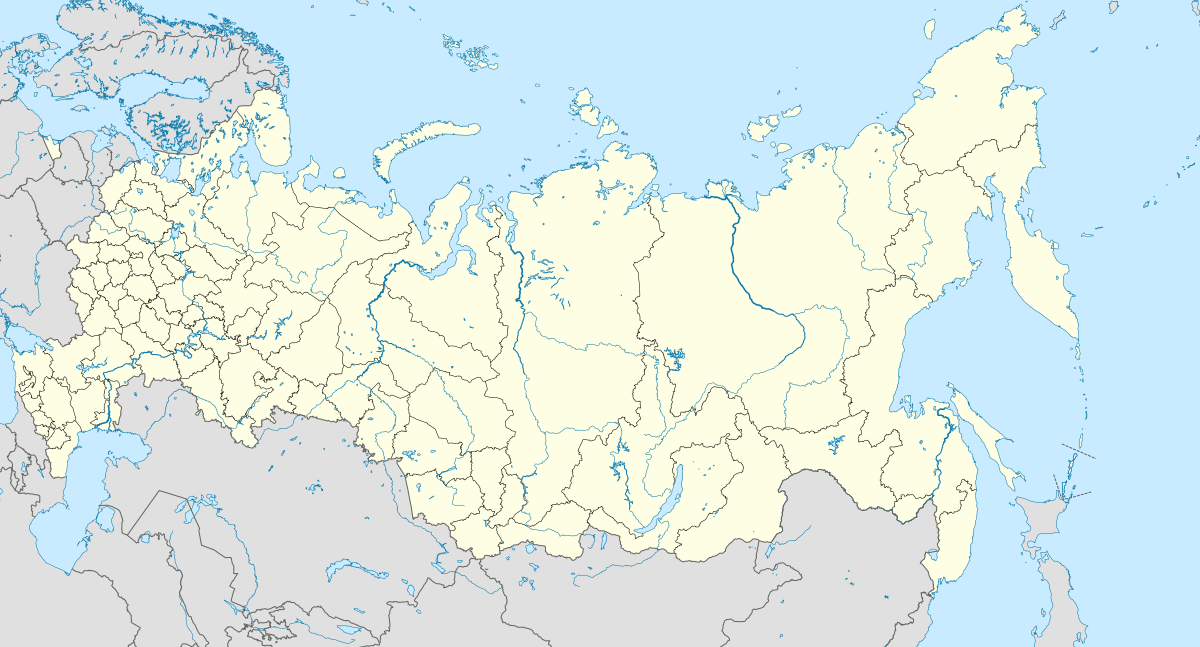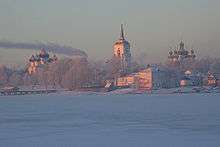Kargopol
Kargopol (Russian: Ка́ргополь) is a town and the administrative center of Kargopolsky District in Arkhangelsk Oblast, Russia, located on both sides of the Onega River, several miles north of Lake Lacha, in the southwestern corner of the oblast. Population: 10,214 (2010 Census);[2] 11,192 (2002 Census);[7] 12,495 (1989 Census).[8]
Kargopol Каргополь | |
|---|---|
Town[1] | |
.png) Coat of arms | |
Location of Kargopol 
| |
 Kargopol Location of Kargopol  Kargopol Kargopol (Arkhangelsk Oblast) | |
| Coordinates: 61°30′N 38°56′E | |
| Country | Russia |
| Federal subject | Arkhangelsk Oblast[1] |
| Administrative district | Kargopolsky District[1] |
| Town of district significance | Kargopol[1] |
| First mentioned | 1146 |
| Elevation | 120 m (390 ft) |
| Population | |
| • Total | 10,214 |
| • Estimate (2018)[3] | 10,062 (-1.5%) |
| • Capital of | Kargopolsky District[1], town of district significance of Kargopol[1] |
| • Municipal district | Kargopolsky Municipal District[4] |
| • Urban settlement | Kargopolskoye Urban Settlement[4] |
| • Capital of | Kargopolsky Municipal District[4], Kargopolskoye Urban Settlement[4] |
| Time zone | UTC+3 (MSK |
| Postal code(s)[6] | 164110 |
| OKTMO ID | 11618101001 |
History
It is not clear when Kargopol was founded, but, when first chronicled in 1146, it was a trade station of the Novgorod Republic and one of the most northerly permanent Slavic settlements. Although documentation for its early history is scarce, it is believed that Kargopol was the most significant trade center of Bjarmaland throughout the 13th and 14th centuries. In 1447, it was the place where Dmitry Shemyaka found refuge from Vasily II's ire.
Situated on the ancient route between Moscow and Arkhangelsk (then the only Russian seaport), Kargopol became one of the most prosperous cities of Russia, especially after the Muscovy Company started to operate in the mid-16th century. During the Time of Troubles it withstood a siege by Polish and Lithuanian brigands. The peasant rebel Ivan Bolotnikov was executed in Kargopol in 1608.
After Russia regained access to the Baltic Sea and St. Petersburg was founded, Kargopol gradually faded to obscurity. However, the people of Kargopol were still active in the exploration of Asian Russia. Alexander Baranov, the first governor of Russian America (Alaska), was born in this town.
Administrative and municipal status
Within the framework of administrative divisions, Kargopol serves as the administrative center of Kargopolsky District.[1] As an administrative division, it is incorporated within Kargopolsky District as the town of district significance of Kargopol.[1] As a municipal division, the town of district significance of Kargopol, together with the village of Zazhigino in Pavlovsky Selsoviet of Kargopolsky District, are incorporated within Kargopolsky Municipal District as Kargopolskoye Urban Settlement.[4]
Economy
Industry
Timber industry serves as the basis of the industry of Kargopolsky District. The linum production factory, which used to exist in Kargopol until the 1970s, is defunct.[9]
Transportation
Kargopol is connected by a paved road with Nyandoma and further east the principal highway in the region, M8 connecting Moscow and Arkhangelsk. There is a road to the north, which connects to M8 via Plesetsk and Brin-Navolok. This is the historic trading route which connected Kargopol with Arkhangelsk before the railroad was built and long stretches of this road are still unpaved. The stretch between Kargopol and Plesetsk was paved in 2011.[10] Another unpaved road in the western direction crosses the border with the Republic of Karelia and heads to Pudozh.
There is no railroad in Kargopol, even though at the time of construction of the railway between Vologda and Arkhangelsk—a decision taken by Tsar Alexander III in June 1894—it was the biggest town in the region, and the railway was constructed through unpopulated areas. There is an urban legend stating that Kargopol merchants were unhappy with the prospective of the railway construction in Kargopol, thinking it would deteriorate the trade, and therefore requested the railway to be built in detour. As a matter of fact, the local governance body, the Kargopol Duma, in September 1894 twice discussed the issue, came to the conclusion that the railroad construction indeed would deteriorate the trade, but that if it does not pass Kargopol, the damage would be much stronger. Therefore, on both occasions, the Duma sent a petition requesting that the railway would be rerouted via Kargopol. This did not occur since the construction had already started in August 1894, and since the detour would have been too big, as Kargopol is not on a straight line connecting Vologda with Arkhangelsk.[11]
The Onega is only navigable between Kargopol and Lake Lacha, since there are rapids downstream of Kargopol.
There is an airport in Kargopol, but since at least the early 1990s it has only been used for transporting cargo.
Climate
| Climate data for Kargopol | |||||||||||||
|---|---|---|---|---|---|---|---|---|---|---|---|---|---|
| Month | Jan | Feb | Mar | Apr | May | Jun | Jul | Aug | Sep | Oct | Nov | Dec | Year |
| Average high °C (°F) | −9 (16) |
−7 (19) |
— | 5 (41) |
13 (55) |
18 (64) |
20 (68) |
17 (63) |
11 (52) |
3 (37) |
−2 (28) |
−6 (21) |
5 (41) |
| Daily mean °C (°F) | −12 (10) |
−10 (14) |
−4 (25) |
1 (34) |
8 (46) |
13 (55) |
16 (61) |
13 (55) |
8 (46) |
1 (34) |
−4 (25) |
−9 (16) |
2 (36) |
| Average low °C (°F) | −16 (3) |
−13 (9) |
−8 (18) |
2 (36) |
4 (39) |
9 (48) |
12 (54) |
9 (48) |
5 (41) |
— | −6 (21) |
−12 (10) |
−1 (30) |
| Average precipitation days | 28 | 23 | 22 | 18 | 17 | 17 | 16 | 18 | 18 | 23 | 27 | 29 | 256 |
| Source: Weatherbase[12] | |||||||||||||
Culture and recreation
Today, Kargopol is a sleepy historical town adjoining the Kenozersky National Park. It is best known in Russia for Kargopol toys (Kargopolskiye igrushki), which are small, simple clay figures painted in traditional style.[13]
During its golden age in the 17th century, Kargopol became home to a highly localized brand of medieval Russian architecture. Quite a few wooden and white stone churches survive in the town and its vicinity. The earliest of these buildings is the black-domed Cathedral of the Nativity of Christ, built of dolomite by Novgorodians and consecrated in 1562. The interior features a curious iron hand sticking from the drum. A hallmark of Kargopol churches is delicate stone carving.

The Kargopol stone churches are classified as historical and architectural heritage and include:[14]
- Cathedral of the Nativity of Christ (1552–1562) with the bell-tower (1766–1767)
- Resurrection Church (end of the 17th century)
- Church of the Nativity of Saint John the Baptist (1740–1751)
- Holy Trinity Church (1790–1802)
- Presentation Church (1803)
- an ensemble of three churches: the Annunciation Church (1692), the Saint Nicholas Church (1741), and the Church of the Nativity of the Theotokos (1678–1680)
_%D0%BF%D0%BB%D0%BE%D1%89%D0%B0%D0%B4%D1%8C.jpg)
Kargopol is classified as a historical town by the Ministry of Culture of Russian Federation, which implies certain restrictions on construction in the historical center.[15]
The only state museum in the town is the Kargopol State Museum of History, Art, and Architecture, founded in 1919.[16] This is a cloak organization, which not only holds ethnographic, art, and historic exhibits, but also protects some of the architectural monuments in Kargopol and surroundings. Fifteen buildings, including a number of churches, are museum property. There are also two private museums in Kargopol.
Kargopol "Bigfoot"
Kargopol is also known throughout the Russian northwest for its numerous alleged sasquatch (bigfoot) sightings. The best known legend is reported to have happened in the early 1990s and was documented by authors.[17] Maya Bykova and Vadim Makarov (in his book Atlas of the Snowman[18]) According to the legend, about 6 kilometers (3.7 mi) from Kargopol, two hairy creatures, one a large "mother", the other its "child", made their way towards a military barracks. A young soldier on guard duty noticed the creatures and hurried back to the barracks for help. The sasquatch, carrying its young, entered behind the soldier. Although making non-threatening gestures and sounds, the creature was attacked by a soldier (who promptly passed out due to the overwhelming stench coming from the creature). Frightened, the creature ran away into the forest. As many as a dozen soldiers are reported to have witnessed these strange creatures on this night.
References
Notes
- Государственный комитет Российской Федерации по статистике. Комитет Российской Федерации по стандартизации, метрологии и сертификации. №ОК 019-95 1 января 1997 г. «Общероссийский классификатор объектов административно-территориального деления. Код 11 218», в ред. изменения №278/2015 от 1 января 2016 г.. (State Statistics Committee of the Russian Federation. Committee of the Russian Federation on Standardization, Metrology, and Certification. #OK 019-95 January 1, 1997 Russian Classification of Objects of Administrative Division (OKATO). Code 11 218, as amended by the Amendment #278/2015 of January 1, 2016. ).
- Russian Federal State Statistics Service (2011). "Всероссийская перепись населения 2010 года. Том 1" [2010 All-Russian Population Census, vol. 1]. Всероссийская перепись населения 2010 года [2010 All-Russia Population Census] (in Russian). Federal State Statistics Service.
- "26. Численность постоянного населения Российской Федерации по муниципальным образованиям на 1 января 2018 года". Federal State Statistics Service. Retrieved January 23, 2019.
- Law #258-vneoch.-OZ
- "Об исчислении времени". Официальный интернет-портал правовой информации (in Russian). June 3, 2011. Retrieved January 19, 2019.
- Почта России. Информационно-вычислительный центр ОАСУ РПО. (Russian Post). Поиск объектов почтовой связи (Postal Objects Search) (in Russian)
- Russian Federal State Statistics Service (May 21, 2004). "Численность населения России, субъектов Российской Федерации в составе федеральных округов, районов, городских поселений, сельских населённых пунктов – районных центров и сельских населённых пунктов с населением 3 тысячи и более человек" [Population of Russia, Its Federal Districts, Federal Subjects, Districts, Urban Localities, Rural Localities—Administrative Centers, and Rural Localities with Population of Over 3,000] (XLS). Всероссийская перепись населения 2002 года [All-Russia Population Census of 2002] (in Russian).
- "Всесоюзная перепись населения 1989 г. Численность наличного населения союзных и автономных республик, автономных областей и округов, краёв, областей, районов, городских поселений и сёл-райцентров" [All Union Population Census of 1989: Present Population of Union and Autonomous Republics, Autonomous Oblasts and Okrugs, Krais, Oblasts, Districts, Urban Settlements, and Villages Serving as District Administrative Centers]. Всесоюзная перепись населения 1989 года [All-Union Population Census of 1989] (in Russian). Институт демографии Национального исследовательского университета: Высшая школа экономики [Institute of Demography at the National Research University: Higher School of Economics]. 1989 – via Demoscope Weekly.
- Нефёдова, Татьяна (2004). Каргопольский район: Прошлое, настоящее и будущее русского Севера. Отечественные Записки (in Russian) (4 (18)). Retrieved June 12, 2011.
- Запущена "Дорога в космос" (in Russian). «Дорожное агентство «Архангельскавтодор». September 22, 2011. Retrieved September 25, 2011.
- Студенцова, Е. О. (2009). Уездные города России / Влияние Вологодско-Архангельской железной дороги на экономическое развитие г. Каргополя в конце XIX—начале ХХ в. (in Russian). Kargopol.
- "Weatherbase: Historical Weather for Kargopol'". Retrieved June 30, 2011.
- Дурасов, Г. П. (1986). Каргопольская глиняная игрушка. Leningrad: Художник РСФСР.
- Памятники истории и культуры народов Российской Федерации (in Russian). Russian Ministry of Culture. Retrieved June 2, 2016.
- "Приказ Министерства культуры Российской Федерации, Министерства регионального развития Российской Федерации от 29 июля 2010 г. N 418/339 г. Москва "Об утверждении перечня исторических поселений"" (in Russian). Российская газета. September 29, 2010. Retrieved October 24, 2011.
- Каргопольский государственный историко-архитектурный и художественный музей (in Russian). Каргопольский государственный историко-архитектурный и художественный музей. Retrieved June 12, 2011.
- http://www.bigfootencounters.com/creatures/russian.htm
- Atlas of the Snowman
Sources
- Архангельское областное Собрание депутатов. Областной закон №258-внеоч.-ОЗ от 23 сентября 2004 г. «О статусе и границах территорий муниципальных образований в Архангельской области», в ред. Областного закона №224-13-ОЗ от 16 декабря 2014 г. «Об упразднении отдельных населённых пунктов Соловецкого района Архангельской области и о внесении изменения в статью 46 Областного закона "О статусе и границах территорий муниципальных образований в Архангельской области"». Вступил в силу со дня официального опубликования. Опубликован: "Волна", №38, 8 октября 2004 г. (Arkhangelsk Oblast Council of Deputies. Oblast Law #258-vneoch.-OZ of September 23, 2004 On the Status and Borders of the Territories of the Municipal Formations in Arkhangelsk Oblast, as amended by the Oblast Law #224-13-OZ of December 16, 2014 On Abolishing Several Inhabited Localities in Solovetsky District of Arkhangelsk Oblast and on Amending Article 46 of the Oblast Law "On the Status and Borders of the Territories of the Municipal Formations in Arkhangelsk Oblast". Effective as of the day of the official publication.).
- Brumfield, William. Kargopol: Architectural Heritage in Photographs (Moscow: Tri Kvadrata, 2007). ISBN 978-5-94607-083-6 (in English and Russian)
External links
- Architectural heritage of Kargopol http://www.pomorsu.ru/Brumfield/Gallery4/kargopol_e.html (in English and Russian)
- Kargopol: Star of the Russian North
.png)